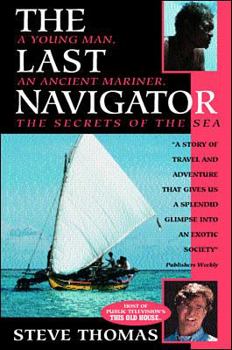The Last Navigator
Select Format
Select Condition 
Book Overview
Explains how the Micronesian's ancient skills of navigation are at risk as its young people turn to Western ways. This description may be from another edition of this product.
Format:Paperback
Language:English
ISBN:0070645744
ISBN13:9780070645745
Release Date:October 1997
Publisher:International Marine Publishing
Length:307 Pages
Weight:1.15 lbs.
Dimensions:0.9" x 6.0" x 9.0"
Customer Reviews
5 ratings
Awesome story
Published by Thriftbooks.com User , 14 years ago
In Hawai'i they call it "chicken skin" what I get every time I tell someone about the skills Steve Thomas describes in this book. It's about a westerner's exposure to depth of environmental knowledge embodied in a micronesian deep water pilot's unerring navigation among the islands of the south Pacific. And about the culture that produced it. No sextant or GPS just the waves, the winds, the stars, the animals and currents. And it and the respect it requires are disappearing.
Entering an Ancient World
Published by Thriftbooks.com User , 16 years ago
I read Steve Thomas' book in the evenings while I was staying at Trader's Ridge Resort on Yap. Steve's clarity and attention to detail taught me not only about the rudiments of traditional oceanic navigation, but also opened my eyes more fully to Micronesian culture, and attuned me to how delicately it hangs between the encroachments of the West and the timeless pace of these islands. Even if you will never see a sailing canoe, this book will change your life. Well done.
Maritime anthropology as adventure travel, with drama.
Published by Thriftbooks.com User , 25 years ago
This book is one of the few good 1980's attempts to document the voyaging culture of the Caroline Islands of Micronesia. It follows Kenneth Brower's 'Song For Satawal', which is now out of print! Plenty of authentic stuff to make this a good read even if you get queasy at the insecurities and soul-searching and quest for meaning that pervades this account of one man's unique adventure in the Pacific. There is lots of interesting anthropology (or is it sociology?) here, such as the system for ownership and preservation/protection of marine resources. Good background for anyone working in resource management in the Pacific.The image that sticks in my mind after reading this book is the agonizing, slow-motion demise of traditional society in the small islands of the Carolines. The Carolines had centuries of Spanish/German/Japanese/USA stepping on their culture, still they managed to resurrect the voyaging skills, but now face the competition of outboards, charts, technological changes. Their oral tradition recorded vast local knowledge of this part of the pacific ocean, but the younger generations for some reason don't have the desire to avail themselves. Youngsters move away, they choose to join the workaday world instead of developing their skills at the traditonal systems that proferred self-sufficiency to their ancestors. The youngsters don't want the old way.The few remaining navigators are at a loss how to preserve the sailing traditions, so one of them accepts a student from Boston, Mass. This guy (the author, Steve) goes to Satawal, home of the greatest surviving ocean-voyaging practitioners, and he spends a LOT of time learning the language, learning the rules, getting informants to tell him about the legends, secret knowledge and systematics of ocean navigation according to the hand-me-down skills of these descendents of the sailors who populated the pacific ocean islands. In the process he manages to get in unpleasant binds over taboos, local politics, and even gets to go fishing and sailing with the natives. The book is liberally salted with the concepts, specifics, and vocabulary of native voyaging, and there is an appendix at the end that gives glossaries, diagrams, etc.
The best of science, courage, navigation lore and adventure.
Published by Thriftbooks.com User , 25 years ago
The original edition of Thomas' saga showed an excellent example of the truly gifted amateur contributing to the practical art of cultural analysis. Drawn to solve a personal intellectual problem on how the early polynesians navigated, Thomas chose the solution of walking in their "mocassins" or paddling in their canoes, learning their language and living their culture. I found his journey as intriguing as the quests of Oliver Sachs(Island of the Color-blind People) or Jared Diamond (Guns, Germs and Civilization) and as intricate as Dva Sobel's tracing of the development of the Chronometer (Longitude). His tool of learning about these people by choosing their most precious historical achievement was inspired. His report by cross-referencing his modern "quantified" vision with their "common sense" qualitative analysis of the sea and its trails is a fascinating tale of multi-cultural experiences. Will he ever return? Even if the island culture is forever changed, one can only hope that he will in some way give us a follow-up picture. Professional scientists and anthropologists should note that Thomas' approach solves the "solipsistic problem" of intercultural communication as effectively as the "Seti Project" hopes to in the future. It is as interesting as Carl Sagan's fiction-- "Contact", but much closer than one might imagine.
excellent story about a man learning to live in ancient time
Published by Thriftbooks.com User , 25 years ago
Steve Thomas's exploration of the ancient way of navigation in the Pacific Ocean, shows how ancient navigators and modern man clash in a strugle of the sea. Thomas learns about himself when he goes to the Pacif to train under the pau to learn ancient ways of sailing. He also learns about his relationship with Pau and his own father in this touching story of sailing and life. I highly recommend this book for anyone intrested in sailing, ancient navigation and the ways other cultures has strugled with the modernization of their land and beliefs.





